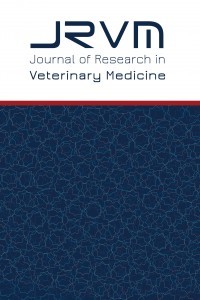Allometric growth of non-carcass components and hind limb tissue composition in Saanen goat kids reared under natural and artificial systems
The aim was to investigate the growth of certain non-carcass components and hind limb tissues using allometric coefficients in Saanen goat kids reared under natural and artificial systems and slaughtered at 80 days or 120 days of age. 42 Saanen kids were used in the study [(24 artificial reared kids (SA-80: 12 kids, SA-120: 12 kids), 18 natural reared kids (SA-80: 9 kids, SA-120: 9 kids)] for determination of indicated parameters. The effect of rearing system was not significant in weights of non-carcass components and hind limb tissue compositions, which indicates that, even though they were fed with milk replacers, artificial reared kids can have similar growth performance when they slaughtered at similar age with natural raised kids. However, slaughter age had significant effect on many non-carcass components, since the weight of the organs increases in parallel with animal’s live weight. It is seen that allometric growth of non-carcass parameters, except skin and testis in both rearing groups and stomach and intestines in natural rearing, was slower (b
___
- 1. FAO, Food and Agriculture Organisation. Crops and livestock products. https://www.fao.org/faostat/en/#data/QCL
- 2. Gökdal Ö. Growth, slaughter and carcass characteristics of Alpine × Hair goat, Saanen×Hair goat and Hair goat male kids fed with concentrate in addition to grazing on rangeland. Small Rumin Res. 2013; 109: 69-75.
- 3. Yalçıntan H, Doğan N, Akın PD, et al. Certain carcass quality characteristics of Saanen Kids in natural and artificial rearing systems. J Anim Prod. 2017; 58(2): 1-6.
- 4. Yalcintan H, Akin PD, Ozturk, N, et al. Carcass and meat quality traits of Saanen goat kids reared under natural and artificial systems and slaughtered at different ages. Acta Vet Brno. 2018; 87: 293-300.
- 5. Oliveira LB, da Graça Morais M, Bertholini Ribeiro C, et al. Allometric growth of body components in crossbred ewe lambs fed increasing dietary concentrate levels. Semin Cienc Agrar, 2017; 38(1): 391-400.
- 6. Akçapınar H. Türkiye koyunculuğunun geleceği hakkında görüşler (in Turkish). J Turk Vet Med Assoc. 1996; 8 (2): 15-17.
- 7. Garcia, IFF, Alvarenga TIRC, Perez JRO, et al. Allometric growth of non-carcass components in crossed lambs. Cie. Rural. 2014; 44: 1229-1235.
- 8. Huxley JS. Problems of Relative Growth. Methuen, London, 1932.
- 9. Colomer-Rocher F, Morand-Fehr P, Kirton AH. Standard methods and procedures for goat carcass evaluation, jointing and tissue separation. Livest Prod Sci. 1987; 17: 149-159.
- 10. Fisher AV, De Boer H. The EAAP standard method of sheep carcass assessment. Carcass measurements and dissection procedures. Report of the EAAP Working Group on Carcass Evaluation, in cooperation with the CIHEAM Instituto Agronomico Mediterraneo of Zaragoza and the CEC Directorate General for Agriculture in Brussels. Livest Prod Sci. 1994; 38: 149-159.
- 11. Galvani DB, Pires CC, Wommer TP, et al. Post weaning growth of the non-carcass components of Texel crossbred lambs. R Bras Zootec. 2010; 39(7): 1558-1564.
- 12. López JL. Estudio etnólogico y productive de la Agrupación Caprina Canaria. PhD Thesis. Zaragoza University, Spain, 1990.
- 13. Argüello A, Castro N, Capote J, et al. The influence of artificial rearing and live weight at slaughter on kid carcass characteristics. J Anim Vet Adv. 2007; 6(1): 20-25.
- 14. Rajkumar V, Agnihotri MK, Das AK, et al. Effect of age on carcass characteristics and meat quality of Sirohi goat kids reared under semi-intensive and intensive management systems. Indian J Anim Sci. 2010; 80 (8): 775-780.
- 15. Zurita-Herrera P, Bermejo JVD, Argüello Henríquez A, et al. Effects of three management systems on meat quality of dairy breed goat kids. J Appl Anim Res. 2013; 41(2): 173-182.
- 16. Panea B, Ripoll G, Horcada A, et al. Influence of breed, milk diet and slaughter weight on carcass traits of suckling kids from seven Spanish breeds. Span. J. Agric. Res. 2012; 10(4): 1025-1036.
- 17. Kaić A, Cividini A, Potočnik K. Influence of sex and age at slaughter on growth performance and carcass traits of Boer kids. 20th Int. Symp. Animal Science Days, Sept. 19th-21th 2012, Kranjska gora, Slovenia, 2012.
- 18. Karim SA, Porwal K, Kumar S, et al. Carcass traits of Kheri lambs maintained on different system of feeding management. Meat Sci. 2007; 76: 395-401.
- 19. Peña F, Perea J, Garcia A, et al. Effects of weight at slaughter and sex on the carcass characteristics of Florida suckling kids. Meat Sci. 2007; 75(3): 543-550.
- 20. Morand-Fehr P, Bas P, Schmidely P. Effect du sevrage sur la croissance et la qualite´ des carcasses de chevreux. 37th Annual Meeting of European Association of Animal Production. Budapest, Hungary, 1986.
- 21. Santos CL. Estudo do crescimento e da composição química dos cortes da carcaça de cordeiros Santa Inês e Bergamácia. PhD Thesis, Universidade Federal de Lavras, Minas Gerais, 2002.
- 22. Dhanda JS, Taylor DG, Murray PJ. Part 1. Growth, carcass and meat quality parameters of male goats: effects of genotype and liveweight at slaughter, Small Rumin Res. 2003; 50(1-2): 57-66.
- 23. Marichal A, Castro N, Capote J, et al. 2003. Effects of live weight at slaughter (6, 10 and 25 kg) on kid carcass and meat quality. Livest Prod Sci. 2003; 83: 247-256.
- 24. Sabbioni A, Beretti V, Ablondi M, et al. 2018. Allometric coefficients for carcass and non-carcass components in a local meat-type sheep breed. Small Rumin. Res. 2018; 159, 69-74.
- 25. de Sousa, MAP, Lima ACS., Araújo JC, et al. Tissue composition and allometric growth of carcass of lambs Santa Inês and crossbreed with breed Dorper. Trop Anim Health Prod. 2019; 51, 1903-1908.
- Başlangıç: 1981
- Yayıncı: Bursa Uludağ Üniversitesi
Sayıdaki Diğer Makaleler
Funda TERZİ, Yavuz ULUSOY, Bahadır KILINÇ, Ayşe Gül DAL, Rabi SALİK
Veli ÇIRAK, Andreas SCHMİDT-RHAESA, Kader YILDIZ
Mehmed Berk TOKER, Selim ALÇAY
